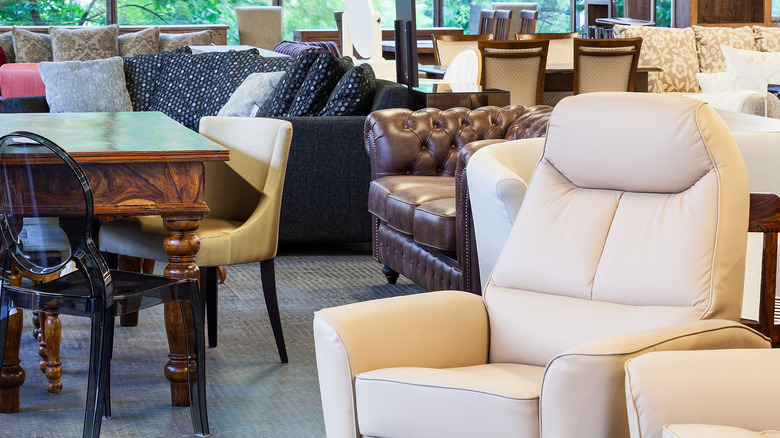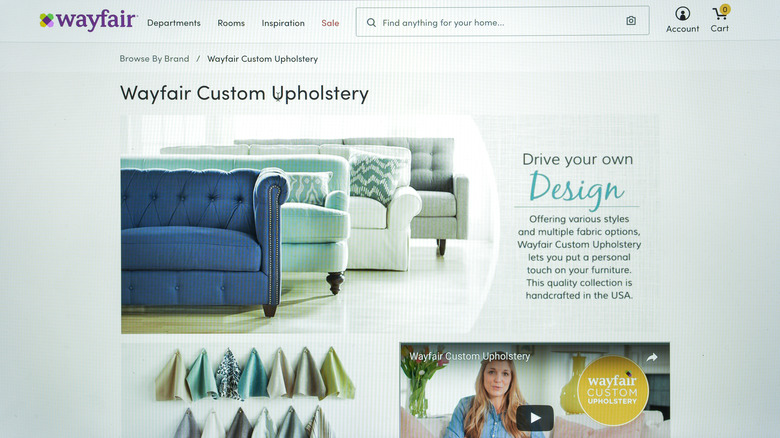Mistakes Everyone Makes When Shopping At Wayfair
Wayfair is a popular e-commerce furnishings and home-goods retailer. According to Den Garden, it's the extensive selection of styles and products that draws customers in; the same is true regarding the wide range of available price points. The lifestyle website lists a user-friendly format and free shipping for most items as additional pros. Bloomberg adds that Wayfair has been able to work around most freight and supply chain issues, meaning customers can expect to receive items within a reasonable timeframe. In fact, consumer advocate site Query Sprout felt their delivery times were quick and exceeded expectations.
Many consumers prefer the convenience of shopping from home, although Query Sprout notes that products generally require assembly, which can surely be an inconvenience. And, while the company has a limited 30-day return policy, there are costs, logistics, and a lot of repackaging associated with returns. Wayfair's site may be simple to navigate and filled with a massive array of products to choose from, but private labeling of goods can make it difficult to know if you're getting the best price. To that end, there are some common pitfalls to be aware of when shopping the décor store, and we describe how to avoid them below.
Disregarding potential return costs
Wayfair provides free shipping on orders totaling over $35. However, you'll have to pay for any costs associated with returning items, notes Query Sprout. The site explains that these costs are deducted from your refund, and, depending on the size and weight of the pieces, it could prove to be a prohibitive amount. Furthermore, per Den Garden, the return requirements can be rigid, including the stipulation that all returned items must be shipped in their original boxes in the same unassembled condition they were received in.
Den Garden shares some advice to avoid pricey mistakes, for instance, making yourself completely aware of the policies before committing to a purchase. Next, thoroughly examine the product descriptions and photographs to glean as much information as possible. It's difficult to perceive true colors from a computer monitor; a sofa that looks navy blue on screen might be closer to charcoal gray when you open the box. The item details should provide clarification, however, vague color names can make it more confusing. To that end, the outlet recommends ordering fabric swatches, if available, to illustrate actual shades and textures.
Another important step when shopping for large furniture is to measure your space accurately. Wayfair offers a 3D planning tool to assist with room layout. Additionally, design services, which could further guarantee making selections that you'll want to keep once you receive them, are available for a supplemental fee.
Ignoring customer reviews
One of the biggest challenges in regards to making purchases online, is that you're unable to interact with the products firsthand until they've been shipped to your home. This can be especially true when buying a piece of upholstered furniture, where comfort is key. Fabric color, as mentioned above, is notoriously tricky to capture with a digital display.
Query Sprout suggests relying on the feedback of our fellow consumers to help us reach a decision, and reminds us that searches can be filtered by customer ratings — which range from one to five stars — along with price, size, and features, among other categories. However, they advise that if you're attracted to something with a less-than-stellar rating, it's worth taking the time to read the detailed reviews. Occasionally, a poor review is unrelated to the quality or appearance of the product, and may instead be a reflection of something else, like the delivery experience.
Overpaying
According to Vox, Wayfair has approximately 80 house brands by which they organize their products for a more streamlined experience. These umbrellas are a way to best illustrate the characteristics of a certain style, allowing customers to search by desired aesthetic. Vox notes that over 70% of sales are derived from these house brands, which are privately labeled collections manufactured by a third-party vendor, then marketed to appear as a standalone brand or an exclusive offering. These items can appear across different retailers at varying prices, and the distinct labeling makes it difficult to comparison shop. Additionally, Vox states that Wayfair's prices frequently fluctuate based on an automated algorithm that considers a set of factors including competition and availability.
Per Investopedia, vendors generally recommend a manufacturer's suggested retail price, or MSRP; the practice aims to ensure the fair trade of products. But the outlet relayed that retailers aren't obligated to price their wares accordingly. Hence, from store to store, the cost for the same item can range significantly. The Sun advises a reverse image search to find duplicate and similar products elsewhere. For even greater reliability, utilize a website called Spoken, which claims to compare exact items and find the least expensive option. In summary, do your homework. Just because something is sold on a mega-marketplace reputed to have good deals, it doesn't always mean you're getting the best value.



